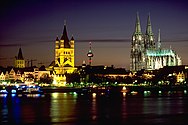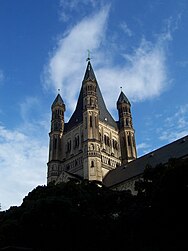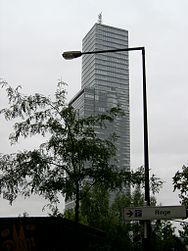Cologne
From Wikipedia, the free encyclopedia.
| Cologne (Köln) | |
|---|---|
 |
 |
| Federal state | North Rhine-Westphalia |
| Administrative region | Cologne |
| District | none |
| Population | 975,907 (2005) |
| Area | 405.15 km² |
| Population density | 2,409/km² |
| Elevation | 37-118 m |
| Coordinates | 50°57′ N 6°58′ E |
| Postal code | 50xxx/51xxx |
| Area code | 0221 |
| Licence plate code | K |
| Mayor | Fritz Schramma (CDU) |
| Website | stadt-koeln.de |

- For other uses, see Cologne (disambiguation).
Cologne (German: Köln ▶(?) [kœln]; Kölsch: Kölle) is, in terms of population, the fourth largest city in Germany and the largest city of the German Federal State of North Rhine-Westphalia. It is best known for its Cathedral, its uniquely brewed Kölsch beer, the original Eau de Cologne, and its celebration of Carnival and Christopher Street Day.
It is one of the most important German inland ports, and considered to be the economic, cultural, and historic capital of the Rhineland. It is the 16th largest city in the European Union. In June 2005, Cologne's population was 975,907, using the standard method of only counting persons whose primary residence (German: Hauptwohnsitz) was in the city. The City of Cologne includes those with non-primary residences (German: Nebenwohnsitz) in its figure, raising it to 1,022,627 (December 31, 2004).
Its location at the intersection of the river Rhine (German: Rhein) with one of the major trade routes between eastern and western Europe was the basis of Cologne's commercial importance. In the Middle Ages it also became an ecclesiastical centre of significance and an important centre of arts and education. Cologne was devastated by Allied air raids the Allies during World War II, by the end of which 99% of Cologne's Jewish population had been annihilated.
Cologne has a large university, which has around 49,000 students (autumn semester 2004/2005) and is renowned for its economics department. In addition to the university, it has three colleges. Fachhochschule Köln (University of Applied Sciences of Cologne), with its 18,000 students, is the biggest college in Germany. A total of 70,000 students study in Cologne.
Cologne is the seat of a Roman Catholic archdiocese. Cologne Cathedral (German: Kölner Dom), a Gothic church, was completed in 1880. In 1996, it was designated a World Heritage site; it is the city's major landmark and unofficial symbol, and claims to house the relics of the Three Kings. The city is 43% Roman Catholic and 18% Protestant, while 39% of the population professes other religions or none. Until World War II and the ensuing process of urbanisation and influx of refugees from Eastern Germany, Roman Catholics comprised the vast majority of Cologne's residents, and the Catholic cultural influence is strongly present in the city today, particularly regarding the celebration of Carnival.
Cologne has 31 museums. Exhibits range from archeological findings to contemporary painting. Alongside the established places of art exists a thriving arts scene, represented yearly at "Art Cologne", Germany's biggest arts fair.
The city plays a paramount role in Germany's television industry. It is home to Westdeutscher Rundfunk (WDR) - the biggest branch of Germany's first public broadcaster ARD - since 1926 [1]. When the market was opened for commercial television stations in Germany in the 1980s, Cologne established itself as home base for several of those stations, RTL being the biggest and commercially most successful one. Today, Cologne is home to a wide range of television and film production companies, even though Berlin has attracted parts of the industry after re-unification.
Cologne has an active gay scene and has long been known for its easy-going, tolerant attitudes. The city is a stronghold of Germany's gay movement and the headquarters of Germany's largest gay and lesbian lobby group. Although Berlin receives more international attention, Cologne still hosts Germany's biggest Gay Pride event known as Christopher Street Day.
20% of Cologne's population is non-German. 40% of these (or 8% of the total population) are Turkish.
Cologne is well known for its beer, called Kölsch. Kölsch is also the name of the local dialect. This has led to the common joke that Kölsch is the only language you can drink.
The other liquid that Cologne is famous for is Eau de Cologne. At the beginning of the 18th century, Italian expatriate Johann Maria Farina (1685-1766) created a new fragrance and named it after his hometown Cologne, Eau de Cologne (Water from Cologne). In the course of the 18th century the fragrance became increasingly popular. Eventually, Cologne merchant Wilhelm Mülhens secured the name Farina, which at that time had become a household name for Eau de Cologne, under contract and opened a small factory at Cologne's Glockengasse. In later years and under pressure of court battles his grandson Ferdinand Mülhens chose a new name for the firm and their product. It was the house number that was given to the factory at Glockengasse during French occupation of the Rhineland in the early 19th century, number 4711. In 1994, the Mülhens family sold their company to German Wella corporation. Today, original Eau de Cologne (German: Kölnisch Wasser) still is produced in Cologne by both the Farina family (Farina gegenüber since 1709), currently in the eighth generation, and by Procter & Gamble who took over Wella in 2003.
In 2005 Cologne hosted one of the largest-ever meetings of Catholic youth. The 20th World Youth Day took place from Monday, August 15, until Sunday, August 21 and over a million people celebrated mass (vigil) at Marienfeld (Mary's Field) in the presence of Pope Benedict XVI.
Contents |
Geography
The city covers about 405.15 km² (about 156 miles²), is located at 50° 56′ 33″ N, 06° 57′ 32″ E, and is between 37.5 and 118.04 m above sea level. Its car registration prefix is K.
The Coat of Arms of Cologne
The three crowns symbolise the Magi or Three Kings whose bones are said to be kept in a golden sarcophagus in the Cathedral (see Shrine of the Three Kings at Cologne Cathedral). In 1164, Cologne's archbishop Rainald of Dassel brought the relics to the city, making it a major pilgrimage destination.
The eleven flames are a reminder of the Britannic princess St. Ursula and her legendary 11,000 virgin companions who were supposedly martyred by Attila the Hun at Cologne for their Christian faith in 383 A.D. In reality, the entourage of St. Ursula and the number of victims was probably significantly smaller.
History
Main article: History of Cologne
Cologne became a city in 50 A.D., had a bishop as early as 313, and, in 785, became the seat of an archbishop. The Archbishop of Cologne was one of the seven Electors of the Holy Roman Empire. He ruled a large area as a secular lord in the Middle Ages, but in 1288 he was defeated by the Cologne citizens and forced to move to Bonn. Cologne was a member of the Hanseatic League, but became a free city officially only by 1475.
Cologne lost its free status, and regained its archbishopric during the French period, and, in 1815, at the Congress of Vienna was made part of the kingdom of Prussia. Cologne became an industrial city, and the current cathedral, started in 1248 but abandoned in the mid-1500s, was eventually finished in 1880.
During the nineteenth and twentieth centuries, Cologne incorporated numerous surrounding towns, and by the time of World War I had already grown to 600,000 inhabitants. In World War II, it was repeatedly bombed, and much of the city was in ruins. It took some time to rebuild the city, but afterwards it grew again, and, in 1975, reached 1 million inhabitants for about one year.
Twinned cities
|
|
By merging in other cities and communes, Cologne took over their partnerships, with the following: Benfleet/Castle Point (England), Igny (France), Diepenbeek (Belgium), Brive-la-Gaillarde (France), Dunstable (England), Eygelshoven (Netherlands) and Hazebrouck (France).
Buildings and Places of Interest in Cologne
Cologne's city center was completely destroyed in World War II. The reconstruction of the city, while respecting the old layout and naming of the streets, followed the style of the 1950ies. Thus, the city today is characterized by simple and modest post-war buildings, with few interspersed pre-war buildings which were reconstructed due to their historical importance.
- In 310 Constantine builds a bridge over the Rhine at Cologne.
- Cologne Cathedral (der Kölner Dom) is the city's famous landmark.
- University of Cologne
- Fragrance-Museum Farina House, the birthplace of Eau de Cologne.
- Wallraf-Richartz Museum
- Museum Ludwig
- Römisch-Germanisches Museum (English: Roman-Germanic Museum)
- Kölner Philharmonie (English: Cologne Philharmonics)
- Ford Motor Company plants, assembling the Ford Fiesta and Ford Fusion as well as manufacturing engines and parts.
- RheinEnergieStadion, the major Cologne soccer stadium, seating 50,997 visitors in national games and 46,134 in international games, home to the local Bundesliga team, 1.FC Köln, and to the local NFL Europe team, the Cologne Centurions.
- Kölnarena, a multifunctional stadium, home to the local ice hockey team, the Kölner Haie (English: Cologne Sharks).
- Kölnturm (English: Cologne Tower), with 150 metres in height Cologne's second tallest building, second only to the cathedral.
- Colonius - a telecommunication tower with an observation deck.
- Colonia-Hochhaus - Germany's tallest residential building.
- Rheinseilbahn - an aerial tramway crossing the Rhine.
- Messeturm Köln (English: Fair/Exhibition Tower Cologne).
- Hohe Strasse (literally: 'high street') is one of the main shopping areas and extends past the cathedral in an approximately southern direction. This street is particularly popular with tourists and contains many giftshops, clothing stores, fast food restaurants and electronic goods dealers / the area around Apostelnstrasse, Ehrenstrasse, and Rudolfplatz, on the other hand, is a little more on the eccentric and stylish side and far more interesting than Hohe Strasse.
- Historic Ringe boulevards (such as Hohenzollernring, Kaiser-Wilhelm-Ring, Hansaring) with their medieval city gates (such as Hahnentorburg on Rudolfplatz) are also known for their nightlife.
Legalities
Cologne is the only city in Germany with an explicit tax on prostitution and other sex businesses. See the article on prostitution in Germany for details.
Born in Cologne
This is a list of famous Germans, whose roots can be found in Cologne:
- Adenauer, Konrad (January 5, 1876 - April 19, 1967), politician and German Chancellor between 1949 and 1963
- Böll, Heinrich (December 21, 1917 - July 16, 1985), writer and winner of the Nobel prize for literature in 1972
- Kier, Udo (born October 14, 1944), actor
- Millowitsch, Willy (January 8, 1909 - September 20, 1999), actor and playwright
- Liebert, Ottmar (born February 1, 1961), musician
- Offenbach, Jacques (June 20, 1819 - October 5, 1880), composer
- Vondel, Joost van den (November 17, 1587 - February 5, 1679), poet and playwright
External links
Official Information
- Cologne, official Cologne portal
- City of Cologne, official City of Cologne information portal for inhabitants
- Domforum, Cologne Cathedral's official website
- University of Cologne
- Churches of Cologne
- Cologne Museums
- Cologne Philharmonics
- Cologne Zoo
Tourism and Travel
- Cologne Tourist Board
- Cologne Traffic Information
- Cologne Airport
- KVB - Cologne Public Transportation
- Photo Gallery
- Eau de Cologne Museum
- 20th World Youth Day 2005
- Cologne City Map at stadtplan.net
- 250 pictures with guide of Cologne's places of interest
- Cologne City Panoramas - Panoramic Views and Virtual Tours
- Travel guide to Cologne from Wikitravel
Culture and History
| Cities and Districts in the German Federal State of North Rhine-Westphalia (NRW) | ||
|---|---|---|
|
Cities |
Aachen | Bergisch Gladbach | Bielefeld | Bochum | Bonn | Bottrop | Dortmund | Duisburg | Düsseldorf | Essen | Gelsenkirchen | Hagen | Hamm | Herne | Köln (Cologne) | Iserlohn | Krefeld | Leverkusen | Mönchengladbach | Mülheim | Münster | Oberhausen | Remscheid | Solingen | Wuppertal |
|
|
Districts |
Aachen | Borken | Kleve (Cleves) | Coesfeld | Düren | Ennepe-Ruhr | Euskirchen | Gütersloh | Heinsberg | Herford Hochsauerland | Höxter | Lippe | Märkischer Kreis | Mettmann | Minden-Lübbecke | Oberbergischer Kreis Olpe | Paderborn | Recklinghausen | Rheinisch-Bergischer Kreis | Rhein-Erft-Kreis | Rhein-Kreis Neuss Rhein-Sieg-Kreis | Siegen-Wittgenstein | Soest | Steinfurt | Unna | Viersen | Warendorf | Wesel |








